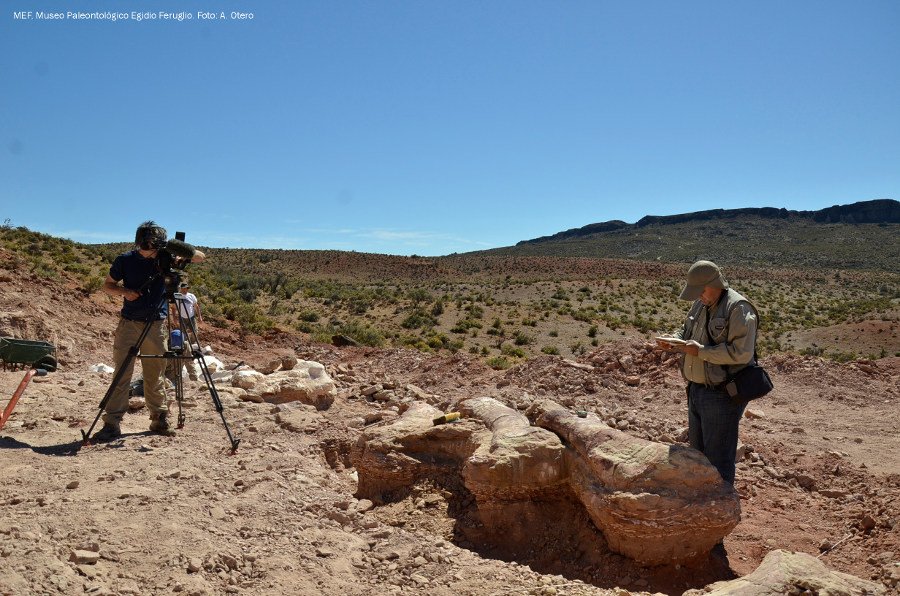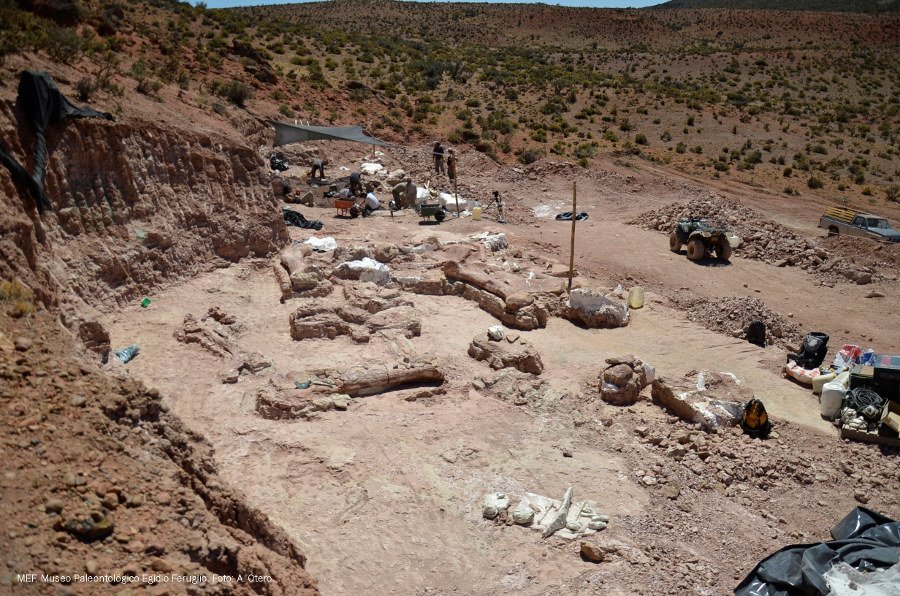Research article on the “Titanosaur” is published: The scientific name of the new species and its importance for understanding the evolution of titanosaur dinosaurs.
The research article conducted by a multidisciplinary team, that took four years, is published in the scientific journal Proceedings of the Royal Society of London (United Kingdom). Scientists have given an official name to the new species: Patagotitan mayorum, which gives information that helps understanding key aspects on the evolution of titanosaur sauropods.

In the year of 2012, a ranch workman called Aurelio Hernández discovered the first bone of what later would become one of the most amazing discoveries in paleontology: over 150 fossils belonging to at least 6 individuals of a new giant dinosaur species that is the largest known so far. Not only the huge size of the fossils draw attention, but also the amount of pieces found, that allow to have the most complete anatomic reconstruction of the largest terrestrial herbivores in the history of our planet.
Since then, news had gone round the world. “When first news of the finding came out in 2013, the dig was still active. We had seen many bones on the field that showed certain features that indicated this was a new species and, apparently, the largest one found until then. From that moment, numerous field trips were carried out to unearth the fossils, which were later prepared at labs in the Museo Egidio Feruglio (Trelew, Argentina). It was only then that we could start studying the material to determine which exactly were the features that would allow identify this new species”, Dr. José Luis Carballido from the Egidio Feruglio Paleontology Museum (Mef), explains. He is a specialist in sauropod dinosaurs, and leading author of this publication. Today, as a result of four years of research, this work is published in the scientific journal Proceedings of the Royal Society of London. The project was carried through by a multidisciplinary team involving specialists in dinosaurs José Luis Carballido and Diego Pol (CONICET- MEF, Trelew), Alejandro Otero (CONICET- Museo de La Plata), Ignacio Cerda and Leonardo Salgado (CONICET-Universidad Nacional de Río Negro), as well as geologists Alberto Garrido (MPCNJO, Zapala), Jahan Ramezzani (MITC, Massachusetts, USA), Rubén Cúneo and Marcelo Krause (CONICET-MEF). Each of them analyzed several aspects of this giant and its surroundings.

The largest dinosaur in the world, so far informally known as the “Titanosaur”, was given its formal name by researchers: Patagotitan mayorum. This work includes the most relevant facets of the discovery: a full description of the new species, an estimation of the body mass, an examination on these animals’ probable age and death causes, and a phylogenetic analysis that allows understand some key aspects in the evolution of large dinosaurs that were unknown before.
The place, a feature and a tribute: the meaning of the name.
The generic name, Patagotitan, has two meanings: “Patago” is in reference to the geographic origin of the fossils, Patagonia; “titan” stands for strength and big size, having its origins in the powerful gods from Greek mythology called titans. The whole word can be interpreted as “giant from Patagonia”. The specific name “mayorum” is in honor and thanks to the Mayo family, owner of La Flecha Farm (the place where the fossils were found), who contacted the specialists. During the excavation works, the Mayo gave their hospitality to over 15 people including paleontologists, geologists, students and volunteers.
Four years we had to wait to know this dinosaur name, and that was due to the time the research work took. “When we discover a new dinosaur in the field, it does not mean that we baptize it as soon as we return to the museum; this is a process that takes a lot of work. In this case, the excavation took three years, and the later preparation at the museum labs took another two years before the actual study could begin; after that, the research was conducted” Carballido details.
In order to establish the fossils belonged to a new species, researchers had to study other large dinosaur species already known. “We compared the remains with all the species that could be related to Patagotitan, not only in terms of size but also also those that lived at the same time or had certain features in common – Carballido adds -. Among them we included species such as Argentinosaurus, Puertasaurus and Futalognkosaurus, which are other giant species of dinosaurs from Argentina. We performed a detailed comparison against all these species and found some striking differences, despite the fact that some of them were very incomplete, like for example Puertasaurus.
Two different techniques to estimate body mass
“Estimating the body weight of an extinct animal is a challenging task. We only have left the bones and from these remains we have to infer the body weight through the use of indirect methods”, Diego Pol comments.

The first estimations of Patagotitan body mass were made by measuring the circumference in a femur and a humerus, which are the main limb bones that support most of the animal weight. The obtained data was input into an equation that allowed estimate it would weigh around 70 tons, equivalent to more than 10 African elephants together.
Paleontologists also used another method: estimating the body mass from the body volume. “To achieve this, a tridimensional reconstruction of Patagotitan was made: on the first place, a scanning of each fossil had to be performed – Carballido specifies -; later on, a reconstruction of what its possible soft tissue volume would be like was added to be able to calculate its weight by comparing it to living animal’s density” This technique hadn´t been used on other giants before, since there weren´t enough fossil remains as to have such a complete reconstruction.
The reconstruction of the facts and the keys to understand their behavior
Just like in a crime scene, the researchers’ team worked in the field collecting data from the site and taking notes of each bone’s exact position and conditions. This aimed to try to understand how these animals died, how old they were and their death causes. “We found three different levels with bones in the same excavation, all of them belonging to one same species. The environment in which those bones were deposited and buried was a floodplain, where successive river overflows had covered the dead animals’ remains. These overflows energy wasn’t strong enough as to move the bones. In other words, these dinosaurs were there, died there and had gone to that place in at least three different occasions”, Carballido details.

Fidelity to a place is a behavior that can be noticed in living animals of social life. José Luis explains: “In one of the levels there is a femur that, clearly, had been stepped on by another animal. At present, this is something common in places where elephants come back frequently, for example; it is very normal that they step on another elephant that was dead before” .Research conducted on the bone tissue of several specimens revealed that all of the dinosaurs that usually came to that place were young adults.
The largest and the smallest: the “genealogy tree” of Patagotitan
This species was commonly known as titanosaur, but in fact that is the name for a group of sauropod dinosaurs that share certain common features. This means, Patagotitan is a titanosaur. “In general looks, titanosaurs are like all the other sauropods: long neck, small head, long tail and walked on four legs; but they have some anatomical characteristics, especially on the tail vertebrae and on the hip bones, that share among themselves and differentiate them from the rest”, Carballido explains. Titanosaurs were a diverse lineage of herbivorous dinosaurs that includes from the smallest species, like Rinconsaurus or Saltasaurus that would weigh around 6 tons (approximately the same tan an adult elephant), to the most gigantic species known, such as Argentinosaurus or Puertasaurus, both of which probably weighed over 60 tons.

Much was unknown about the evolution of sauropods, especially the largest ones. “Something interesting to go over was how size evolved among titanosaurs, since this is the group with the widest size disparity of all sauropods – Diego Pol expresses. The phylogenetic study (utilized to solve evolutionary relations between species) we performed indicates that most of the giant titanosaurs known in Patagonia belong to a single lineage. This means that the evolution of extreme gigantism within titanosaurs happened but only once, and not in multiple separate events. We can see some other cases of size increase relative to the ancestral size of titanosaurs, but none of them was as dramatic as the one seen in this group and exemplified by Patagotitan. This means that apparently almost all the truly giant dinosaurs were related to each other and form the group known as Lognkosauria. This group of giants probably emerged by the end of the Lower Cretaceous (Patagotitan would be the oldest) and had survived until the middle Upper Cretaceous (between 100 and 85 million years ago)”.